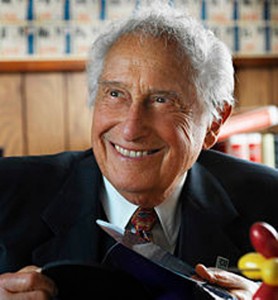The well-respected Detroit entrepreneur and inventor Stanford Ovshinsky died Thursday at his suburban Detroit home. An autodidact whose knowledge covered a vast range of technical and scientific fields, Ovshinsky was 89.
Ovshinsky founded Energy Conversion Devices, among other high-tech firms he had hoped would be able to profit on the hundreds of patents credited to him. His work largely focused on so-called amorphous, or non-crystalline, structures that Ovshinsky was eventually able to put to use in fields as far-reaching as automotive batteries, solar cells and photocopiers.
His amorphous technologies are widely used in electronics and hybrid cars – the latter often relying on the environmentally friendly nickel-metal hydride battery he helped pioneer. The technology also proved useful in flat-screen liquid crystal displays and had shown promise as a fuel storage system for hydrogen fuel cell vehicles.
Possibly the most amazing thing about Ovshinsky was that he was self-taught; he had no formal college training. That has led to numerous comparisons to another legendary American autodidact, Thomas Edison.
The key to most of Ovshinsky’s work was the development of the amorphous switch that Ovshinsky developed while working at General Automation. In contrast to the silicon technology used in most computers, amorphous switches are based on a non-crystalline molecular structure. Along with brother Herb Ovshinsky, he helped build a mechanical version of a nerve cell. Ovshinksy called this amorphous thin-film switch the Ovitron. In building the Ovitron, he also pioneered the use of nanostructures.
Ovshinsky and his soon-to-be second wife, Iris, started Energy Conversion Laboratory in a Detroit storefront in 1960. There, he hoped to find solutions to important societal problems through technology and science. Even in the early ‘60s, when gasoline was cheap and long before environmentalism became fashionable, Ovshinsky was looking for ways to make fossil fuels obsolete.
In 1964, the couple reconstituted ECL as Energy Conversion Devices. While the company was credited with developing an enormous array of technologies using Ovshinsky’s breakthroughs it struggled financially for many years and was forced to sell off many potentially lucrative patent rights at a steep discount to raise much-needed capital. That often put Ovshinsky at odds with investors.
Hoping to put a more professional management team in place, Ovshinsky hired former General Motors Chairman Robert Stempel to serve as ECD’s chairman in 1995. The two had previously collaborated on the groundbreaking GM EV1 battery car which used ECD’s batteries. Stempel served as chairman for nearly 12 years. Stempel passed away in May 2011.
In 2007, following Iris’ death, Ovshinsky left ECD and started another company, Ovshinsky Innovation, where he worked on new energy technologies. Ovshinsky remarried for the third time later that year to Rosa Young, a physicist who previously had worked at ECD.
Rochester Hills-based ECD makes flexible thin-film solar panels through its subsidiary United Solar Ovonic, as well as batteries. After Ovshinsky’s departure, ECD continued to struggle financially and filed for bankruptcy protection earlier this year.
It is unclear how Ovshinsky’s death will impact his newest firm but in the final year of his life OI was working on a range of projects related to clean energy.
Ovshinsky grew up in Akron, Ohio, before moving to the Detroit area. He is survived by his brother and longtime partner at ECD, Herb; his third wife, Rosa; three children; four stepchildren; and six grandchildren.
Paul A. Eisenstein contributed to this report.

